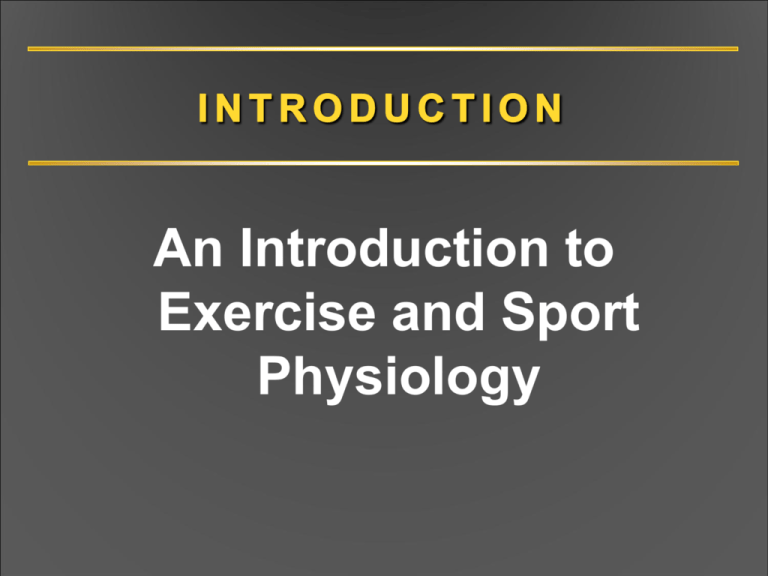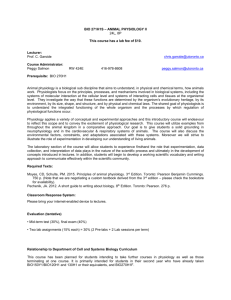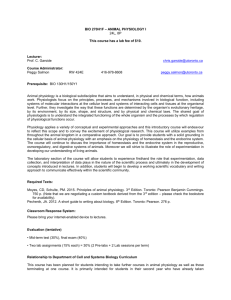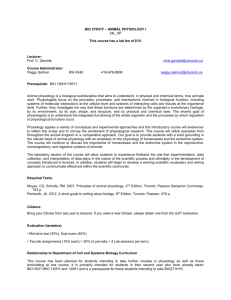
An Introduction to
Exercise and Sport
Physiology
INTRODUCTION Overview
• Focus of exercise and sport physiology
• Acute and chronic responses to exercise
• The evolution of exercise physiology
• Research: the foundation for understanding
Focus of Exercise
and Sport Physiology
• Physiology is the study of the function of organisms.
• Homeostasis is the maintenance of a constant
internal environment.
Focus of Exercise
and Sport Physiology
• Exercise physiology is the study of how body
structure and function are altered by exposure to acute
and chronic exercise.
• Environmental physiology is the study of the
effects of the environment on the function of the body.
• Sport physiology is the application of the concepts
of exercise physiology to training athletes and
enhancing sport performance.
Acute and Chronic Responses
to Exercise
• Acute exercise is a single bout of exercise.
• Chronic adaptation is a physiological change that
occurs when the body is exposed to repeated exercise
bouts over a period of weeks or months. These
changes generally improve the body’s efficiency at rest
and during exercise.
Early Exercise Physiologists
• Archibald V. Hill
– Nobel Prize winner (1921)
– Studied energy metabolism
in isolated frog muscle
– Conducted first
physiological studies on
runners
Photo courtesy of American
College of Sports Medicine
Archives.
Early Exercise Physiologists
• John S. Haldane
– Developed methods of measuring oxygen use
during exercise
– Known for his work in human physiology and
respiration
The Harvard Fatigue Laboratory
• Founded by biochemist Lawrence J.
Henderson
• Directed by David Bruce Dill (D.B. Dill)
• Focused on the physiology of human
movement and the effects of environmental
stress on exercise
• Most contemporary exercise physiologists
can trace their roots back to the Harvard
Fatigue Laboratory.
The Harvard Fatigue Laboratory:
Early Measurements
• Collected expired air in a sealed bag known
as a Douglas bag
• A sample of the gas from the Douglas bag
was then measured for oxygen and carbon
dioxide using a chemical gas analyzer.
The Harvard Fatigue Laboratory:
Early Measurements
Scandinavian Influence
• Eric Hohwü-Christensen
– In the late 1930s, published an important series of
five research studies on carbohydrate and fat
metabolism
• Per-Olof Åstrand
– During the 1950s and 1960s, conducted studies on
physical fitness and endurance capacity
• Jonas Bergstrom
– Reintroduced the biopsy needle in 1966 to study
human muscle biochemistry
Scandinavian Exercise Physiologists
Eric Hohwü-Christensen
Photos courtesy of the authors.
Bengt Saltin
Jonas Bergstrom (left) and Eric Hultman (right)
Contemporary Exercise Physiologists
• John Holloszy and Charles Tipton
– Introduced biochemical approach to exercise
physiology research
– First to use rats and mice to study muscle
metabolism and fatigue
• Reggie Edgerton, Phil Gollnick, and Bengt
Saltin
– Studied individual muscle fiber characteristics and
their responses to training in rats and humans
Contemporary Exercise Physiologists
John Holloszy
Charles Tipton
Phil Gollnick
Photo of John Holloszy courtesy of American College of Sports Medicine Archives. All rights reserved. Other photos courtesy of the authors.
Exercise Physiology Milestones
• Peter Karpovich, Springfield College
– Helped introduce physiology to physical education
• Thomas K. Cureton, University of Illinois
– Helped support a rationale for using exercise to
promote a healthy lifestyle
• Elsworth Buskirk, Penn State University
– Established The Laboratory for Human Performance
Research in 1974
Women in Exercise Physiology
• Birgitta Essen
– Collaborated with Bengt Saltin and Phil Gollnick in
publishing the earliest studies on human muscle
fiber types
• Karen Piehl
– Among the first to demonstrate that the nervous
system selectively recruits type I and type II fibers
• Barbara Drinkwater
– Among the first to address issues specifically related
to the female athlete
Research: Ergometers
• Ergometers are used to measure physical
work under standardized conditions.
• Treadmills and cycle ergometers are the
most commonly used types.
Research: Ergometers
Research Designs
• Longitudinal research tests the same
subjects and compares results over time.
• Cross-sectional research collects data from
a diverse population and compares groups
in that population.
• Longitudinal studies are often more
accurate than cross-sectional studies, but
are time-consuming and expensive.
Dose-Response Relationships:
Cross-Sectional Study
Dose-Response Relationships:
Longitudinal Study
Research: Confounding Factors
• Many factors can alter the body’s response
to exercise.
• Examples: environmental conditions, time
of day (diurnal variation)
Table 0.1
Table 0.2
Research: Tables and Graphs
• The title will identify what information is
being presented.
• Units for each variable should be clearly
presented.
• Graphs better illustrate
– Trends in data
– Response patterns
– Comparisons of data between subject groups
Research: Interpreting Graphs
• The x-axis is the independent variable or
factor that is controlled by the study design.
• The y-axis is the dependent variable that
will change depending on how the
independent variable is manipulated.
Figure 0.9
Figure 0.10






